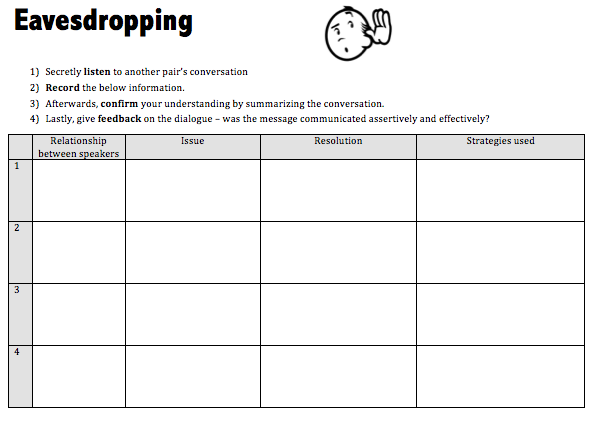ESL Level: Intermediate+
Skill Focus: Listening, speaking, writing.
Class Time Required: 1 hour and 15 minutes.
Eavesdropping is a great ESL activity to get students talking and listening to each other. It can be great practice for conversational elements/strategy (for example: tone, assertiveness), key expressions (e.g. idioms, phrasal verbs), specific details (e.g. recording phone numbers) and more.
Generally, the activity is conducted as follows:
- Teach some target language or a conversation strategy that you want students to put into practice with each other. Let's use the example of idioms.
- Afterwards, elicit the meaning of eavesdropping and discuss it with your students. Is eavesdropping a good or bad thing? Do you eavesdrop to improve your English? Where do we often eavesdrop?
- Have your students refer back to their list of idioms. Put them in pairs, and tell them that you want them to write a dialogue containing two to three of the idioms. Or if you want to make sure all the idioms get used, you can cut up the idioms onto strips or paper and give two to each group. Also, if you don't want to spend too much time writing, you can merely have your students think of a conversation in which these idioms would be used without requiring them to write it down word per word (which can take a long time).
- After they have written their dialogue, remind your students of the concept of eavesdropping. Tell them that they are going to eavesdrop on their other classmates' conversations and try to record information. Demonstrate your eavesdropping worksheet (see below for a downloadable sample). (Note: Modify the column headings to match your activity accordingly). Go over the worksheet and explain what information you want them to record.
- Put pairs together with another pair. Have one pair eavesdrop while the other speaks. The eavesdroppers should complete the worksheet while listening. Afterwards, they should summarize what they heard to check their understanding. Lastly, if they are practicing a conversational strategy, e.g. being persuasive, they can comment on how effective the speakers were using this strategy.
- Have the pairs switch roles, and continue.
- Continue the activity until the students have eavesdropped three or four times with different groups. Usually at this point, class ends or they get tired.
I do eavesdropping about one a month, and I find it a great way to practice writing, speaking, and listening. In terms of an integrated ESL activity, it's a winner. Give it a try.
Eavesdropping Activity Worksheet
Download: eavesdropping-esl-template.docx
Note: This was used for an eavesdropping lesson on assertiveness, tact, and constructive criticism, hence the Issue and Resolution columns. If you are focusing on idioms, change these headings to 'key words' and 'idioms used'. You can also add a column for 'Mood' if suitable.
- Copyright Matthew Barton of Englishcurrent.com


Many thanks. This is very useful.